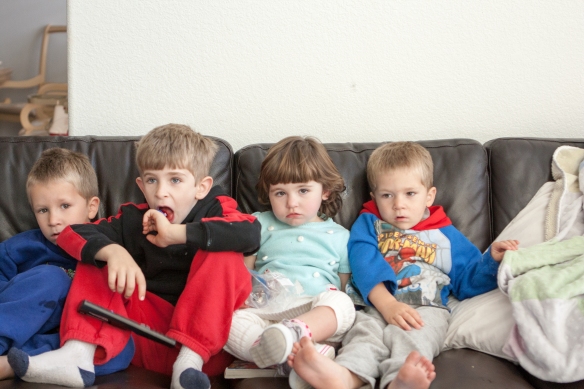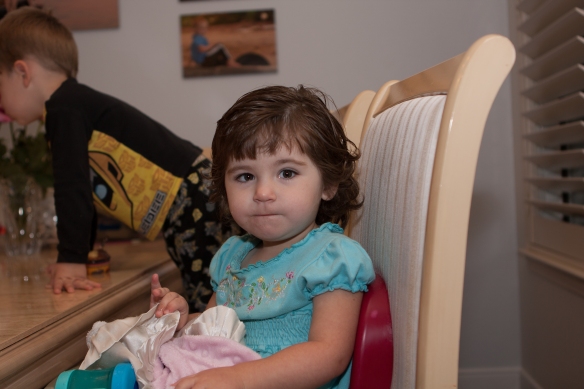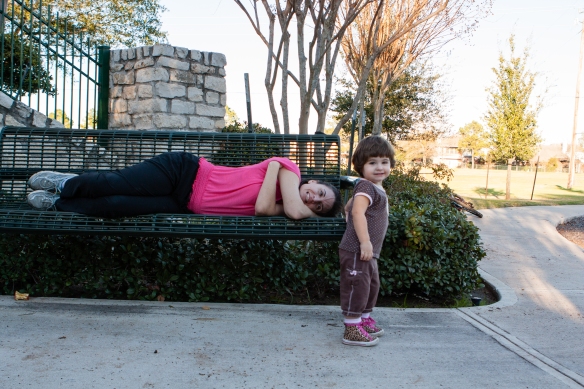I have struggled to write this post like no other. Unending research and editing that evolves into complete rewrites has left me tired. I will cut straight to the chase. A two-hour assessment of Savanna by a specialist resulted in the medical diagnosis of ASD, (Autism Spectrum Disorder) January 13, 2014. Unlike her epilepsy, we were not blindsided with this news as we have seen it coming for some time. You can read the beginnings of concern in the 6 Month Seizure Free post.
[Sidebar. For those finding this post searching for Autism and Epilepsy: a brief history. Savanna was diagnosed with IS and CPS at 12 weeks. Treatment for IS was successful. CPS became medically refractory. She underwent a left TPO resection in 2 stages concluding on 4/1/2013. Still seizure free nearly 1 year later.]
The diagnosing doctor (Dr. F), was very direct, to the point of being hurtful with her demeanor. I think she had the best interest of the patient and family in mind, but it didn’t feel that way during the assessment. I had mixed emotions about the diagnosis. I left the assessment feeling relief, sadness, thankfulness, and a bit of depression all mixed together.
I admit, I do feel some relief from the diagnosis. Why? A trained professional evaluated my daughter and diagnosed her with ASD, a disorder that not only explains many of her difficult behaviors but that gives us new direction and new hope that she will get through this; that we will get through this.
I do feel some sadness from this new diagnosis. I read a lot of similar family blogs and study scientific literature about her situation. From what I have read, these problematic behaviors are not a result of the brain surgery; in that she is ‘only delayed’ and one day will not be delayed, but normal.
I know in my heart the situation is more complex than just the need for extra TLC. We have been adrift in a sea of unknowns, ‘maybes’, and ‘maybe nots’, and I feel thankful for the new direction.
I am thankful someone in the professional medical community sees what I see. Often times I feel alone managing the chronic medical issues of my child. Moments like these I feel support, understanding, and recognition of how difficult the situation is regardless of how well she is progressing relative to her initial prognosis so early in her life.
Then, the doctor leaves the room. You exhale, begin comprehending and embracing every word that person said. I cannot lie; there is a new wave of depression that swells over me. What do I do now? What does this ultimately mean?
As a SAHD (stay-at-home-dad), I am also her daily therapist. I work on compliance, cognition, language, motor skills, etc (outside of all the formal therapy of course). Generally, I do not feel like the ‘fun’ parent despite all efforts to supervise therapy in a play environment. Sometimes, I think I provide security for her, and when she recognizes that it feels good. I struggle with the balance managing time between Savanna, Rebecca, and the other kids.
When Mommy is not working, it is all fun! Mommy can walk down the stairs, scoop up Savanna in dramatic fashion at the end of any given day, and conveniently answer the knock at the door. The visitor is greeted by a Savanna who is suddenly elated to be with Mommy!
Our situation probably looks wonderful to the visitor of 5 minutes. Everybody seems happy during these times. Not even 10 minutes prior she was entrenched in an epic battle for some reason; tears, screaming – you name it.
It is then too that communication ‘about how great everything is’ through video and voice calls occurs.
Everything is great. And, many any of you may wonder what I am talking about, as from afar, nothing seems amiss. I would argue the difficult times are more difficult, but the good times are better and more frequent too. Usually, I don’t like to be in the community when Savanna is having a bad day or time. I don’t take pictures of these times, and usually don’t take video. But, this is becoming unavoidable as time goes on.
It is great to see her learning through the crying, screaming, and wining. I mean this sincerely too, because this was not always the case.
It is great that her motor skills have developed in a way that she is ambulatory and can explore her environment and tackle playgrounds. This has helped tremendously with her emotional regulation.
It is great that she is able to satisfy some of her compulsions as they change. And since we now recognize some of these compulsions, we can help soothe the situation with some proactive measures. For example, we can make sure all the doors are closed in her little environment here, and that mommy’s purse is either out of sight or on left should only. These are known as non-functional rituals.
It is great that she is very aware of every screw hole, or any hole or dimple, in every toy. These discoveries derail therapy sessions and create insatiable obsessions it seems. Trying to control this behavior is challenging. This is known as a preoccupation with a part of an object. While often cute to the casual observer, it is abnormal in intensity and focus.
It is great that she loves yogurt covered raisins. It is unfortunate that she will eat almost nothing else. Satiation eventually occurs and the fixation moves to the next ‘favorite food’. She has what is known as a self-limited diet (don’t we all at some level?), but hers is severely limited. This keeps us dependent on her feeding port more than we hoped at this point in the journey.
It is great to hear her babbling about two to three sounds with what seems like some communicative intent. We must be patient, because every child talks at a different time. This is what everyone tells us. But as the weeks and months pass… what then? We continue to model words with practical function but her rate of acquisition of these particular skills is very slow at best. It is frustrating for her and us too.
Most of our friends and family are eager to debate or discredit the ASD diagnosis in a loving and well-meaning manner. “All kids do these things. My [normal] kid did ________ when they were little.” Or, “My friend’s child would only eat ______ for a year…and they were normal.”
I would like to just agree with you collectively and move on.
Many of you also may wonder “She is so young. How can [they] tell she is Autistic?” Autism is a clinical diagnosis at this time. It requires either a medical professional to diagnose the disorder medically or a behavioral therapist to diagnose it from a behavioral perspective. So how do these people diagnose ASD? They both use the same tools.
Specifically, Savanna was diagnosed using the CARS2-ST. (Childhood Autism Rating Scale, 2nd edition, standard version – there exists a version for Asperger’s Syndrome which is –HF), a toolkit developed over a 15 year period from 1971 to 1986 involving more than 1500 patients. You can read all about it with a quick internet search. Above 30 is considered ASD that is mild to moderate. Above 37 (with some additional factors) is considered ASD that is severe. Savanna’s raw score was 46.5. Standardized results were: T-score of 61 and a percentile rank of 86.5.
The CARS tool is only one modality of measurement. But, scientific evidence shows it aligns well with other methods for diagnosing ASD at her age when employed by trained professionals.
Life can be challenging with a child like Savanna, especially in new and unfamiliar environments. Her compulsive behaviors are cute, but they become restrictive. And, if she can’t satisfy the compulsion, emotional regulation suffers, and attempts to help her regulate have varied outcomes.
When she cannot understand, be understood, or be satisfied, her unhappiness and frustration boils over in 2-3 year old fashion -on steroids. It is different from what I have experienced with our other kids, because they can communicate in a way I understand. With Savanna, I am often left guessing about how to help her. As a result, her behavior varies widely throughout the day.
Yes, I have figured out what she needs and when, for the most part. But addressing her needs in a way that minimizes the screaming really isn’t helping her overcome the communication barrier.
We too are learning as a family. We reinforced bad behaviors at an early point since her second surgery. At the time is seemed harmless and so wonderful that she could laugh and push her brothers – that she was even capable of it! It is not funny anymore. And let me tell you, teaching her to stop such behaviors is its own challenge.
Many believe for children on the spectrum, some of the intense frustrations are rooted in their inability to communicate. I would agree with this generalization with regard to Savanna.
Her intentional communication skills are at about a 12 month range. Even still, she exhibits deficits not present with typical children. This is not a guesstimate or just my opinion, rather the result of years of a scientific approach to measuring and rating speech and communication abilities. Some examples…
She does not eye gaze or a gaze shift when trying to get an object from a person. She does not look at our faces with the intent to understand what we are looking at, or to communicate her desire. This means she doesn’t associate the holder of the juice cup as a necessary part of the conversation to get the cup. She will just continue to scream at the cup instead of shifting her gaze (eye contact) between the holder and the cup, indicating to the holder she wants the cup.
She does not consistently point at anything for any reason, at this time. Yes she points, but it seems random in occurrence even if an appropriate gesture in the moment.
She doesn’t modify her behavior if she isn’t getting what she wants, unless you consider screaming louder a behavior modification (which the therapists don’t!).
Socially, she is not learning from observation in the same way or rate as a normal child learns. At first glance she seems very social. When you watch her longer, you realize there is very little reciprocity (positive or negative) in her behavior which is quite abnormal. I will say though, that having her around all of our other kids (supervised and in free play) is probably her best social therapy. She is learning about social interaction from her siblings in a safe and loving environment.
I have noticed too that diet, gastrointestinal balance, and the right environment can have a dramatic affect on her natural happiness. None of those things are constant though no matter how much we try to keep them that way.
Sometimes, after some torture in the bathtub (otherwise known as: ‘just trying to wash her’), we chase her around the room and she loves it! Mommy plays “I’m gonna get you!!”, and Savanna goes wild with laughter. This happiness is much like happiness our other children experience and is such a blessing at the end of a difficult day.
Our subscription to the science is lifelong and wholehearted. That does not mean we will not question decisions about her care but rather engage our doctors in educated conversation about our options, her options, until she can decide for herself. We will secure as much therapy as appropriate and focus on a new path of learning and new way of learning.
In our last clinic visit, Dr V said this “…let’s see how her language comes along…” The implied relationship of her overall development in relation to her language development is quite profound. I didn’t really understand what she meant at first, or at least the magnitude of it, as she was so nice about how she said it.
The more I research our situation, the more I understand the implied meaning of that statement. Given her experience with such cases, and all of the circumstances, it is probably the best bellwether we have at this time with regard to her ultimate development.
Savanna’s Autism is not classical in the sense most people think of it. Many people say, “She doesn’t look Autistic?” She has a major neurological developmental problem to start with, so perhaps all this is related. An interesting thought: there is nothing to say that person who meets the criteria today but no longer meets the criteria at some point in the future, ever meet the criteria in the first place.
We know undoubtedly that our part in this is to give her the very best chance we can, as much therapy, love (often times tough love), & encouragement as possible.
I have more to share about Savanna, but have been mentally blocked by this essay. I leave you with some nice pictures from the last couple of months, and a video. (The ice pictures are from a recent “winter storm” here in Houston, a rare event I understand.)
So not sure why the video is so challenging in this post. It doesn’t seem to want to play for many. I apologize. I am trying again now.













I feel like this day is coming for us too. But it’s one thing to think and another to have it confirmed. I can only imagine what it is like to wrap your head around it.
LikeLike
At least you won’t be surprised. I think they way our journeys began, you are so much more prepared for what is ‘next’.
With the ASD, the patient range is so wide compared to what we have already encountered. I think that is what makes processing this so difficult for us.
Your work for the TSC community is amazing. Thank you for all your efforts.
-ken
LikeLike
DEAR Becky and Ken, now I understand why we haven’t heard from you. Wow. You have certainly investigated the challenges. You both need twins, a sister for Becky and a brother for Ken. You probably never sleep. Do you have a group of parents that you can share experiences and concerns with or maybe a church group just for fun times. I am so very sorry we aren’t closer. You and all four of your precious children are in our thoughts and prayers.
We love you both and we are sending you blessings, love, hugs and prayers, Aunt Dee and Uncle Allen
Sent from my iPad
LikeLike
Yes, we are connecting with groups from our church and support groups in the area that ‘get it’. We are still reeling a bit, but it does help part of those organizations.
Thank you for the prayers, we need those the most.
-ken
LikeLike
Ken, so glad for another post, saddened about the diagnosis. I know it’s better to have the knowledge. I try to put myself inside Savanna’s mind, and know this is so very frustrating and hard for her, & for you & Becky, & her brothers. Please know that not a day goes by that I don’t pray for all of you. You all have a difficult task, & I know God will give you the skills & strength you need, and will always take care of Savanna. Love you all, Anne
LikeLike
Hi Anne,
It means so much to us that you follow our story. We had hoped to come see you at Christmas, but we were side-swiped by illness (probably just exhaustion). There’s never enough time – but we think of you often & feel every single prayer. Just don’t stop sending them:)
-Rebecca
LikeLike
Hi Ken…it’s me, Ken. No, not your conscience. The other Ken who reads your stuff. Wow, what a mirror image of your brain though, and in many ways, an echo of experiences past. You handle it with a grace I never was capable of…I’ve often found it much too difficult to look past the anger and the frustrations. But reading what you write often helps to remind me of how important it is to key in on the positives. I don’t do it enough.
I always asked myself, especially around Bennett’s ASD Diagnosis, though it was sugar-coated for us initially as PDD-NOS (we got a later upgrade to ASD with the leather interior and heated seats), but I think at first maybe the docs were just trying to ease us into it by giving us extra letters so we’d be more confused, if the ASD was there all along, or if the surgery was somehow a causality of the ASD, since ASD doesn’t have a single known cause.
It makes me often wish I had not chosen art and design as a career path and could go back and choose, oh I dunno…neurology and behavioral psychiatry and other such paths in college and grad school. 😉
I would say ‘Hey, it gets easier.’ But that isn’t really true and you know that. Besides, it gets harder. But I think as parents we grow and adapt and we make a choice, a decision, that it simply will be more manageable for US to cope with this new life. And with that, I am at paragraph 4 which means I have to stop, as ay more means I would be blogjacking…take care!
LikeLike
Oh man, my conscience caught up with me! I always enjoy your opinion and view on the situation. I tip-toed through this post… I am working on another blog about being a SAHD, that will be more raw in expression – not just about being a parent to someone like Savanna, but just being a parent (particularly a SAHD).
You might find that one a bit more ‘real’ and less politically correct when it comes to little life experiences that one might have when in our shoes. I credit a portion of my motivation to undertake this new venture to you sir! …stay tuned….
-ken
LikeLike
Looking forward to that one. Being a SAHD is weird…never really thought about how much before. But now that I think about it, it does have a LOT of stuff attached to it, even though I am actually working some now and the kids are in their various schools, and the dynamic is shifting some, I still have the expectation of not pursuing my career, which would require us to move and me leaving the home full-time. Hmmm…
LikeLike
Pingback: Tip-Toes, Uh-Oh’s, and a little Autism Awareness | Savanna Lininger's Journey